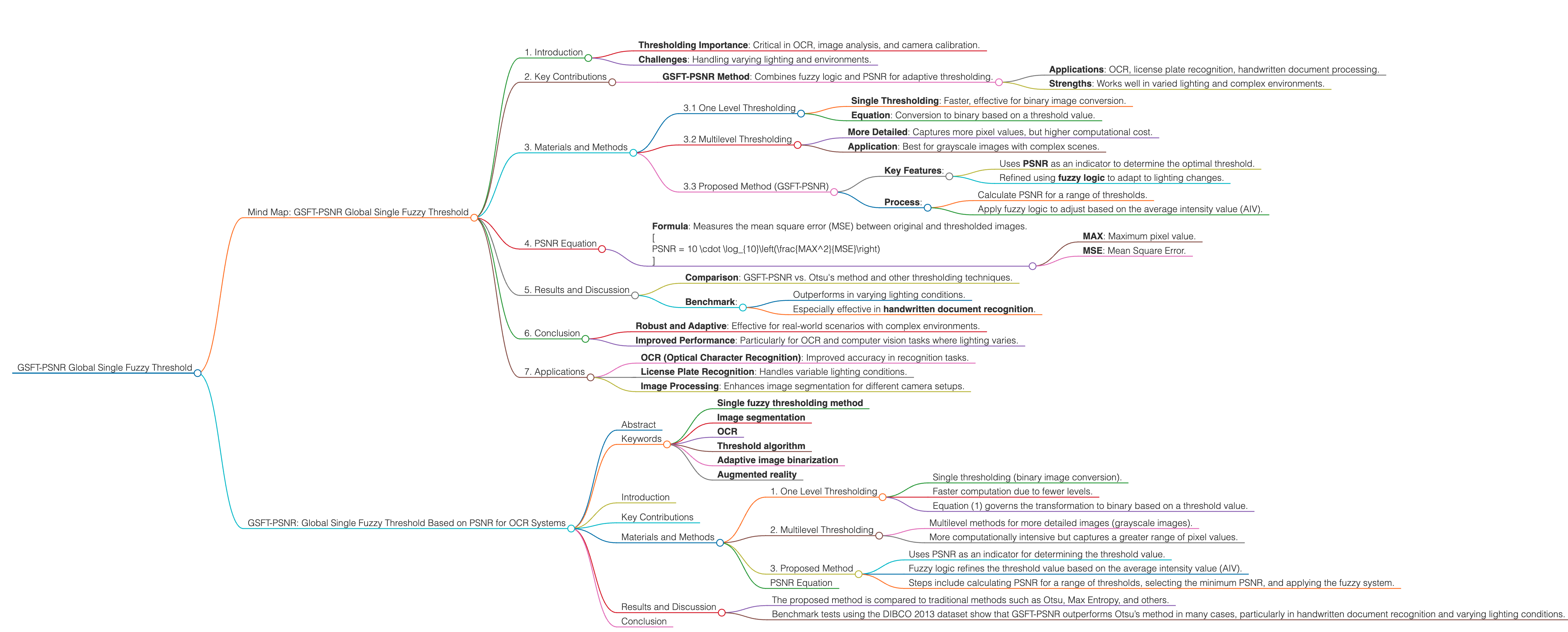GSFT-PSNR_Global_Single_Fuzzy_Threshold

Mind Map: GSFT-PSNR Global Single Fuzzy Threshold
1. Introduction
- Thresholding Importance: Critical in OCR, image analysis, and camera calibration.
- Challenges: Handling varying lighting and environments.
2. Key Contributions
- GSFT-PSNR Method: Combines fuzzy logic and PSNR for adaptive thresholding.
- Applications: OCR, license plate recognition, handwritten document processing.
- Strengths: Works well in varied lighting and complex environments.
3. Materials and Methods
3.1 One Level Thresholding
- Single Thresholding: Faster, effective for binary image conversion.
- Equation: Conversion to binary based on a threshold value.
3.2 Multilevel Thresholding
- More Detailed: Captures more pixel values, but higher computational cost.
- Application: Best for grayscale images with complex scenes.
3.3 Proposed Method (GSFT-PSNR)
- Key Features:
- Uses PSNR as an indicator to determine the optimal threshold.
- Refined using fuzzy logic to adapt to lighting changes.
- Process:
- Calculate PSNR for a range of thresholds.
- Apply fuzzy logic to adjust based on the average intensity value (AIV).
4. PSNR Equation
- Formula: Measures the mean square error (MSE) between original and thresholded images.
[
PSNR = 10 \cdot \log_{10}\left(\frac{MAX^2}{MSE}\right)
]
- MAX: Maximum pixel value.
- MSE: Mean Square Error.
5. Results and Discussion
- Comparison: GSFT-PSNR vs. Otsu’s method and other thresholding techniques.
- Benchmark:
- Outperforms in varying lighting conditions.
- Especially effective in handwritten document recognition.
6. Conclusion
- Robust and Adaptive: Effective for real-world scenarios with complex environments.
- Improved Performance: Particularly for OCR and computer vision tasks where lighting varies.
7. Applications
- OCR (Optical Character Recognition): Improved accuracy in recognition tasks.
- License Plate Recognition: Handles variable lighting conditions.
- Image Processing: Enhances image segmentation for different camera setups.
GSFT-PSNR: Global Single Fuzzy Threshold Based on PSNR for OCR Systems
Abstract
Binarization or thresholding is a critical step in computer vision and image analysis, particularly in applications such as OCR (Optical Character Recognition) and augmented reality. This method separates the foreground from the background in an image, reducing the amount of data to process and improving computational efficiency. Traditional methods like Otsu’s thresholding are compared to a new method called GSFT-PSNR, which uses Peak Signal-to-Noise Ratio (PSNR) and fuzzy logic to determine threshold values. The proposed method shows improvements in various real-world applications such as license plate recognition and handwritten image processing.
Keywords
- Single fuzzy thresholding method
- Image segmentation
- OCR
- Threshold algorithm
- Adaptive image binarization
- Augmented reality
Introduction
Thresholding is a key first step in many computer vision applications, crucial for object recognition, camera calibration, and reducing noise. While single-level thresholding is fast and effective, multilevel thresholding can lead to higher computational time. Global thresholding methods are often favored for their speed, while local thresholding techniques are necessary for more complex scenes.
Key Contributions
The proposed method, GSFT-PSNR, combines global single fuzzy thresholding with PSNR to improve performance in varied lighting and environmental conditions. It is designed to adapt to different ambient illuminations and applications, such as OCR and license plate recognition. GSFT-PSNR excels in handling unstructured environments with variable lighting.
Materials and Methods
1. One Level Thresholding
- Single thresholding (binary image conversion).
- Faster computation due to fewer levels.
- Equation (1) governs the transformation to binary based on a threshold value.
2. Multilevel Thresholding
- Multilevel methods for more detailed images (grayscale images).
- More computationally intensive but captures a greater range of pixel values.
3. Proposed Method
- Uses PSNR as an indicator for determining the threshold value.
- Fuzzy logic refines the threshold value based on the average intensity value (AIV).
- Steps include calculating PSNR for a range of thresholds, selecting the minimum PSNR, and applying the fuzzy system.
PSNR Equation
[ PSNR = 10 \cdot \log_{10}\left(\frac{MAX^2}{MSE}\right) ]
Where MAX is the maximum pixel value, and MSE is the mean square error between the original and thresholded image.
Results and Discussion
- The proposed method is compared to traditional methods such as Otsu, Max Entropy, and others.
- Benchmark tests using the DIBCO 2013 dataset show that GSFT-PSNR outperforms Otsu’s method in many cases, particularly in handwritten document recognition and varying lighting conditions.
Conclusion
The GSFT-PSNR method offers a robust, adaptive thresholding approach that can handle challenging real-world scenarios with varying lighting and complex scenes. By using PSNR as a quality measure and combining it with fuzzy logic, the method improves upon traditional thresholding techniques in OCR and other computer vision tasks.